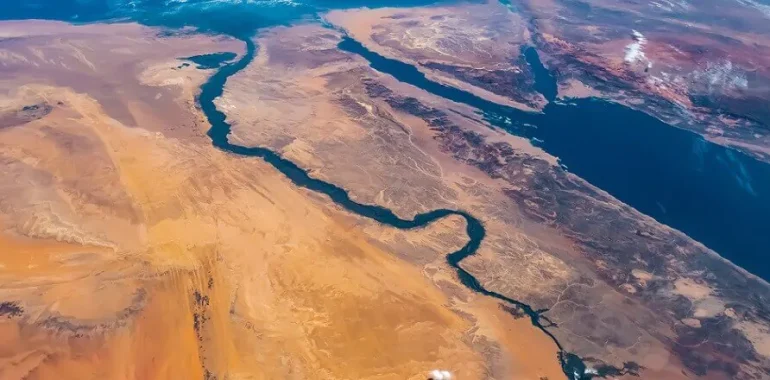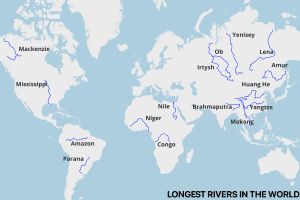
Discover 20 Incredible Longest Rivers in the World
The Longest Rivers in the World , Rivers are among the most vital natural resources on our planet, shaping landscapes, sustaining ecosystems, and providing essential water supplies for human populations. From the ancient Nile to the mighty Amazon, the longest rivers in the world are not just impressive in their length but also rich in cultural, historical, and ecological significance. In this blog post, we will explore the 20 longest rivers in the world, delving into their unique features and the critical roles they play in our environment and societies.
1. Nile River
Length: Approximately 6,650 kilometers (4,130 miles)
The Nile River, often celebrated as the longest river in the world, flows north through eleven countries, including Uganda, Sudan, and Egypt, before emptying into the Mediterranean Sea. Historically, it has been the lifeblood of civilizations, providing fertile soil for agriculture and a vital transportation route. The river’s annual flooding deposited nutrient-rich silt along its banks, enabling the flourishing of ancient Egyptian society.
2. Amazon River
Length: Approximately 6,400 kilometers (3,976 miles)
The Amazon River is the largest river by volume and one of the most biodiverse ecosystems on Earth. Flowing through South America, it supports countless species of flora and fauna and plays a critical role in regulating the planet’s climate. The Amazon River basin is home to numerous indigenous communities who rely on its resources for their livelihoods.
3. Yangtze River
Length: Approximately 6,300 kilometers (3,917 miles)
The Yangtze River, located in China, is the longest river in Asia. It flows from the Tibetan Plateau to the East China Sea, passing through major cities such as Shanghai and Chongqing. This river is crucial for trade and transportation and is known for the Three Gorges Dam, which is the largest hydroelectric project in the world. The Yangtze is a symbol of China’s history and culture, influencing art, literature, and daily life.
4. Mississippi-Missouri River System
Length: Approximately 6,275 kilometers (3,902 miles)
The Mississippi and Missouri Rivers form North America’s longest river system. The Mississippi flows south from Minnesota to the Gulf of Mexico, while the Missouri is its longest tributary. Together, they create a significant transportation corridor for goods and agriculture, shaping the history and culture of the United States.
5. Yenisei River
Length: Approximately 5,539 kilometers (3,445 miles)
The Yenisei River flows through Siberia and is the largest river system draining into the Arctic Ocean. It runs northward, from Mongolia to the Kara Sea. The river is essential for hydroelectric power generation and supports local wildlife. The Yenisei’s tributaries are rich in biodiversity, contributing to the overall health of the region’s ecosystems.
6. Yellow River (Huang He)
Length: Approximately 5,464 kilometers (3,395 miles)
The Yellow River, known as Huang He in Mandarin, is often referred to as the “cradle of Chinese civilization.” It flows through northern China and has been essential for agriculture for centuries, despite its notorious flooding. The river is a symbol of Chinese resilience and culture, representing both the challenges and triumphs faced by its people.
7. Ob-Irtysh River System
Length: Approximately 5,410 kilometers (3,364 miles)
The Ob-Irtysh River System flows through Siberia and Central Asia, eventually reaching the Arctic Ocean. This river system is crucial for transporting goods and resources, especially in remote areas. The Ob River supports diverse wildlife and is an important source of freshwater for the regions it traverses.
8. Paraná River
Length: Approximately 4,880 kilometers (3,032 miles)
The Paraná River flows through Brazil, Paraguay, and Argentina, eventually joining the Rio de la Plata estuary. It is one of the longest rivers in South America and plays a crucial role in the region’s agriculture and transportation. The river is home to the Itaipu Dam, one of the world’s largest hydroelectric power plants, highlighting the delicate balance between energy generation and environmental conservation.
9. Congo River
Length: Approximately 4,700 kilometers (2,920 miles)
The Congo River is Africa’s second-longest river, flowing through countries like the Democratic Republic of the Congo and the Republic of the Congo. Known for its deep waters and strong currents, the Congo is vital for transportation and fishing. The river basin supports diverse ecosystems, including tropical rainforests, and is home to numerous unique species.
10. Amur-Argun River System
Length: Approximately 4,444 kilometers (2,763 miles)
The Amur-Argun River System forms the border between Russia and China. This river system is significant for its ecological diversity and is vital for both countries’ economies. The Amur River supports fishing industries and serves as a critical waterway for transportation.
11. Lena River
Length: Approximately 4,400 kilometers (2,736 miles)
The Lena River is one of the longest rivers in Russia, flowing through Siberia and draining into the Arctic Ocean. It is known for its cold waters and striking landscapes. The Lena River is crucial for local communities, providing fishing and transportation routes in an otherwise harsh environment.
12. Mackenzie River
Length: Approximately 4,241 kilometers (2,635 miles)
The Mackenzie River is the longest river in Canada, flowing through the Northwest Territories and draining into the Arctic Ocean. It is a vital resource for Indigenous communities and is known for its diverse wildlife and beautiful scenery. The Mackenzie River system supports various ecosystems and is essential for local fisheries.
13. Niger River
Length: Approximately 4,200 kilometers (2,611 miles)
The Niger River flows through West Africa, spanning several countries, including Nigeria, Mali, and Niger. This river is crucial for irrigation and agriculture, supporting millions of people who rely on its waters for their livelihoods. The Niger River basin is rich in biodiversity and cultural heritage, with many communities along its banks.
14. Murray-Darling River System
Length: Approximately 3,672 kilometers (2,282 miles)
Located in Australia, the Murray-Darling River System is essential for irrigation and agriculture. The rivers are vital for the country’s economy, supporting the production of crops and livestock. The Murray River is known for its beautiful landscapes and diverse wildlife, making it a popular destination for recreation and tourism.
15. Tocantins-Araguaia River System
Length: Approximately 3,600 kilometers (2,237 miles)
The Tocantins-Araguaia River System flows through Brazil and is significant for transportation and agriculture. This river system supports diverse ecosystems and is home to various wildlife species. The rivers are vital for local communities, providing water resources and supporting fishing industries.
16. Volga River
Length: Approximately 3,530 kilometers (2,194 miles)
The Volga River is the longest river in Europe, flowing through Russia and draining into the Caspian Sea. It is crucial for transportation, industry, and agriculture, playing a significant role in Russian history and culture. The Volga River is often referred to as “Mother Volga,” symbolizing its importance to the Russian people.
17. Indus River
Length: Approximately 3,180 kilometers (1,976 miles)
The Indus River flows through China, India, and Pakistan, serving as a vital water source for agriculture and drinking water. It is one of the longest rivers in Asia and has been central to the development of ancient civilizations, including the Indus Valley Civilization. The river supports diverse ecosystems and is critical for the livelihoods of millions.
18. St. Lawrence River
Length: Approximately 3,058 kilometers (1,900 miles)
The St. Lawrence River flows from Lake Ontario to the Atlantic Ocean, forming part of the border between Canada and the United States. It is an essential waterway for trade and transportation, connecting the Great Lakes to the ocean. The river is rich in history and supports various ecosystems, making it a popular destination for recreation.
19. Rio Grande
Length: Approximately 3,051 kilometers (1,895 miles)
The Rio Grande forms part of the border between the United States and Mexico. It is a crucial source of water for agriculture and communities along its banks. The river has cultural significance for both countries and supports diverse wildlife and ecosystems.
20. São Francisco River
Length: Approximately 3,160 kilometers (1,963 miles)
The São Francisco River flows through Brazil, providing vital resources for agriculture and irrigation. It is known for its unique landscapes and cultural significance, supporting various communities along its banks. The river is often called “The River of National Integration,” symbolizing its importance to Brazil’s development.,List of river systems by length – Wikipedia
Conclusion
The longest rivers in the world are not just impressive geographical features; they are vital lifelines for the ecosystems, cultures, and economies that depend on them. Each river tells a story, shaped by the landscapes they traverse and the communities that thrive alongside them. As we continue to explore and appreciate these remarkable waterways, it is essential to recognize their significance and advocate for their preservation. Rivers are a testament to nature’s power and resilience, and their protection is crucial for the health of our planet.
